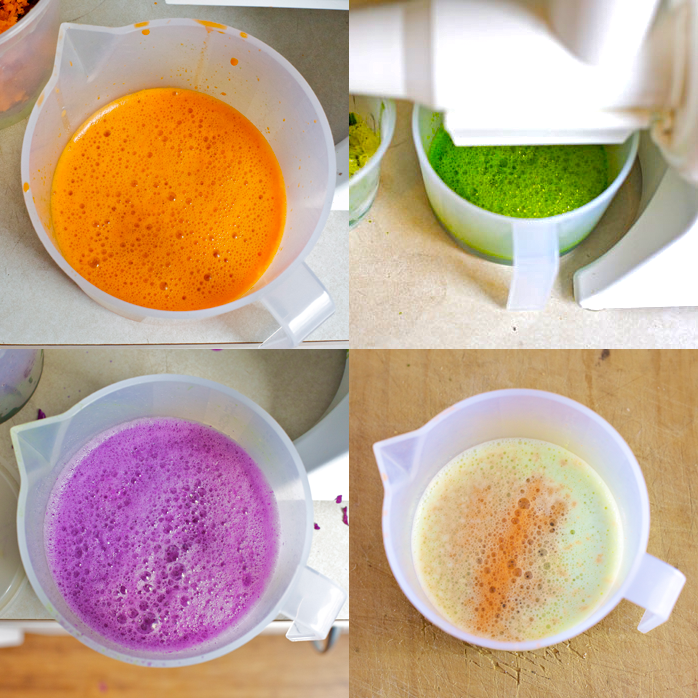8 Ways to Make Organic DIY Food Coloring
 The 21st century world is a very unnatural time to live in. And for the most part, that’s just peachy keen. The Internet, for example, is one modern invention I’m pretty fond of. And I’m glad we have, you know, like . . . doctors, grocery stores, fire-resistant roofing materials and robotic vacuum cleaners that do all the work for you!
The 21st century world is a very unnatural time to live in. And for the most part, that’s just peachy keen. The Internet, for example, is one modern invention I’m pretty fond of. And I’m glad we have, you know, like . . . doctors, grocery stores, fire-resistant roofing materials and robotic vacuum cleaners that do all the work for you!
Yes, postmodern living has its perks. But there’s a dark side, too, in this hyper-processed wonderland. Medicine is fine and dandy and robots are just plain awesome, but what about eating? What about health? What the heck has happened to our food?
The truth is that synthetic replacements just can’t stack up to the real thing, and science doesn’t always have the answers. That’s probably why we’re seeing a widespread resurgence of natural living; a return to a holistic lifestyle.
All of our needs can be met using real, ground-grown produce instead of laboratory engineered products. (Passionate gardeners from Dallas to Anchorage are hard at work for this reason.)
For example, take food dyes. Artificial colorings have been linked to brain tumors and bladder cancer, and affect everything from allergies to attention span. They’re wreaking havoc on our kids, and yet they’re totally unnecessary. So the next time you find yourself reaching for that little bottle of food coloring, why not try some of these alternative ideas instead? Every single one of them is baking-friendly, so your birthday cake will be just as beautiful, and your body will really thank you.
Pink and Red
You can use any number of options, but for a ton of color with almost no flavor, beets are your best bet. Use the juice from the canned kind, or make your own by either boiling or juicing the raw vegetable. Learn exactly how to make frosting colored by beets from Joy the Baker.
Alternately, use any red fruit, like raspberries or pomegranate. Just know that these may change the flavor – which can be a great thing! Lemon cupcakes with real raspberry-infused frosting just happen to be a favorite around these parts. To procure your dye, pulverize the berries in a food processor or blender, then strain out the colored liquid using a mesh sieve or cheesecloth.
Orange
Carrots are your best bet for achieving a perfectly peachy tint. Citrus may seem promising, but it doesn’t lend much color. Stick to carrots and you’re sure to be pleased. Just juice them (or buy fresh carrot juice), and don’t worry about the flavor. Carrots are naturally sweet! Itsy Bitsy Foodies offered a super tutorial on how to make food coloring from carrots.
Yellow
For yellow you’ll need to hit the spice rack. Both saffron flowers and turmeric powder will create that sunny, summery hue. These are each intensely-colored spices, so a little goes a long way. Start with very small amounts and taste as you add. Nouveau Raw published a delicious recipe for raw vegan frosting colored with turmeric. Check it out and then tell me how yellow and delicious it was.
Green
Are you forever trying to find ways of getting greens into your kids? (Or into yourself?!) Well, how about . . . spinach in the frosting! That’s right, a little spinach will work like a charm, and doesn’t impart any flavor at all (PROMISE!).
You can use juice, or you can even use the whole leaves. I recommend that you try The Edible Perspective's recipe for Green Monster Whipped Green Frosting, which includes two cups of spinach leaves.
Another option for that emerald tone involves a “health food” supplement called chlorophyll. Liquid chlorophyll is available in most alternative markets (co-ops, Whole Foods) and is quite inexpensive. Besides its purported health benefits, it’s a great option for natural food coloring.
Blue and Purple
And finally, the tricky twosome. Blues and purples can be a bit harder, but they certainly are possible. Blueberries and blackberries can be used in the same process as described above (for other berries, under “Pink and Red”). But your real best bet is a totally unexpected vegetable: cabbage!
That’s right! Red cabbage can be used to make both purple and blue food coloring. For the former, cut and boil the cabbage until the water is very dark and concentrated. This will give you a pretty purple dye.
For the latter, slowly stir in baking soda, a bit at a time. It will react with the cabbage juice and produce a perfectly pretty blue hue.
And as an alternative, you can use natural food dye in a savory recipe. Food dye isn’t reserved just for sweets and treats!
Remember that working with natural coloring will be different from the artificially amplified colors you’re probably used to. In general you can expect a paler, more pastel-type of result. Experiment, play around with quantities and combinations, add a little at a time, and always taste as you go. Most important, let your creative juices flow, and have fun!
Sayward Rebhal writes for Networx.
Looking for a Pro? Call us (866) 441-6648

Cleaning Average Costs
Cleaning Services Experiences

Concrete Driveway, Sidewalk And Walkway Just The Way We Wanted

Concrete Driveway Expansion Is Strong And Looks Great



